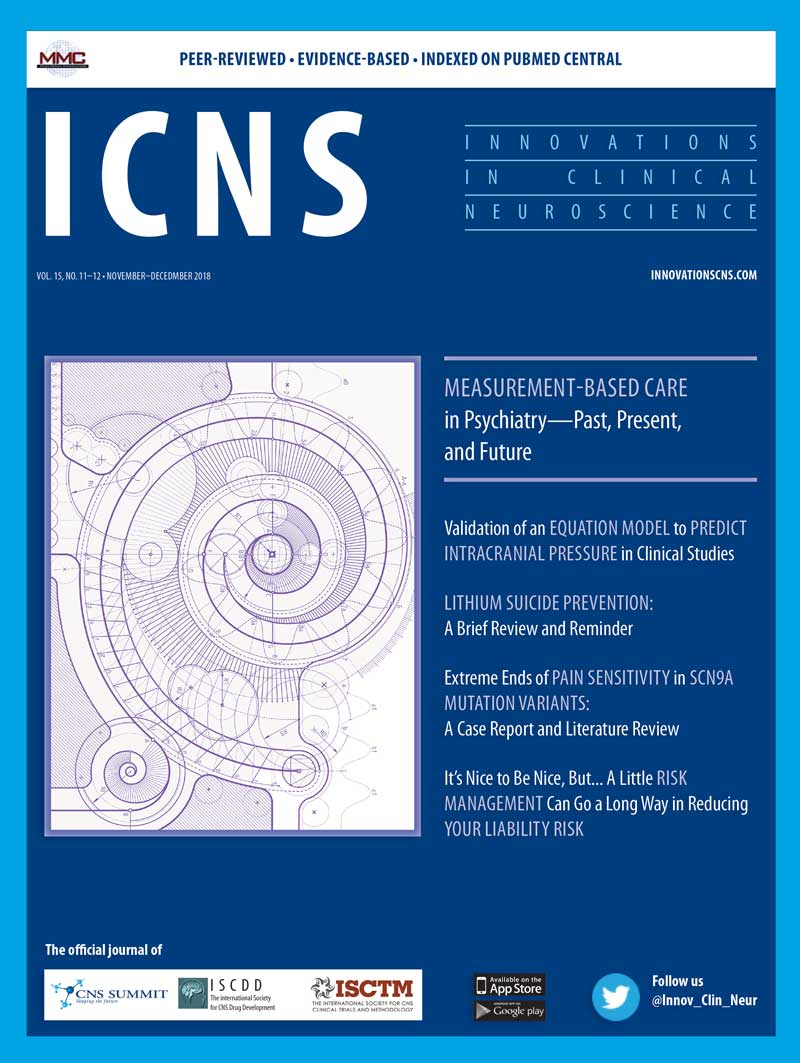 Dear Colleagues:
Dear Colleagues:
Welcome to the November–December issue of Innovations in Clinical Neuroscience (ICNS). We start this issue with an article by Aboraya et al titled “Measurement-based Care in Psychiatry—Past, Present, and Future.” Here the authors define and describe measurement-based care (MBC) in psychiatry as well discuss the research supporting its use in clinical practice. Barriers to implementing MBC in clinical practice and basic properties of MBC instruments, in particular, the Standard for Clinicians’ Interview in Psychiatry (SCIP), are reviewed as well.
Next, Kashara et al present their cross-sectional, observational study, “Validation of an Equation Model to Predict Intracranial Pressure (ICP) in Clinical Studies.” The investigators compared predicted ICP using a specifically developed equation with real ICP measured with an aneroid manometer through lumbar puncture in a cohort of 39 subjects. The authors report that their results support the use of the equation as a proxy method to predict ICP in clinical studies.
Following this, in a brief review titled, “Lithium Suicide Prevention: A Brief Review and Reminder,” Sarai et al review the currently available literature on lithium’s positive effect on suicidality, as well as provide discussion on its proposed mechanisms of action. The authors note that their report should serve as an important reminder to clinicians to include lithium in their armamentarium when considering treatment options for affective disorders, especially in patients who exhibit suicidal behaviors.
Next, Majeed et al present a case report titled, “Extreme Ends of Pain Sensitivity in SCN9A Mutation Variants: Case Report and Literature Review.” The authors present the case of an 11-month-old male infant with SCN 9A gene mutation that resulted in congenital insensitivity to pain, while his mother, with a different mutation of the same gene, had hypersensitivity to pain. The authors provide a brief discussion regarding diagnosis (including differentials), known etiology, and treatment of congenital insensitivity to pain, of which a multidisciplinary treatment approach is recommended.
And finally, in this issue’s installment of Risk Management titled “It’s Nice to Be Nice, But…A Little Risk Management Can Go a Long Way in Reducing Your Liability Risk,” Vanderpool offers suggestions to clinicians on what to do when someone, such as a colleague or a patient, requests your professional services outside the standard treatment protocol. The author presents various examples of situations, such as a patient asking to pay off a bill by providing landscaping services, to illustrate the importance of evaluating your own risk exposure when agreeing to the seemingly reasonable requests of others.
We hope you enjoy this issue of ICNS. As always, we welcome your submissions and feedback.
Sincerely,
Amir Kalali, MD
Editor, Innovations in Clinical Neuroscience





